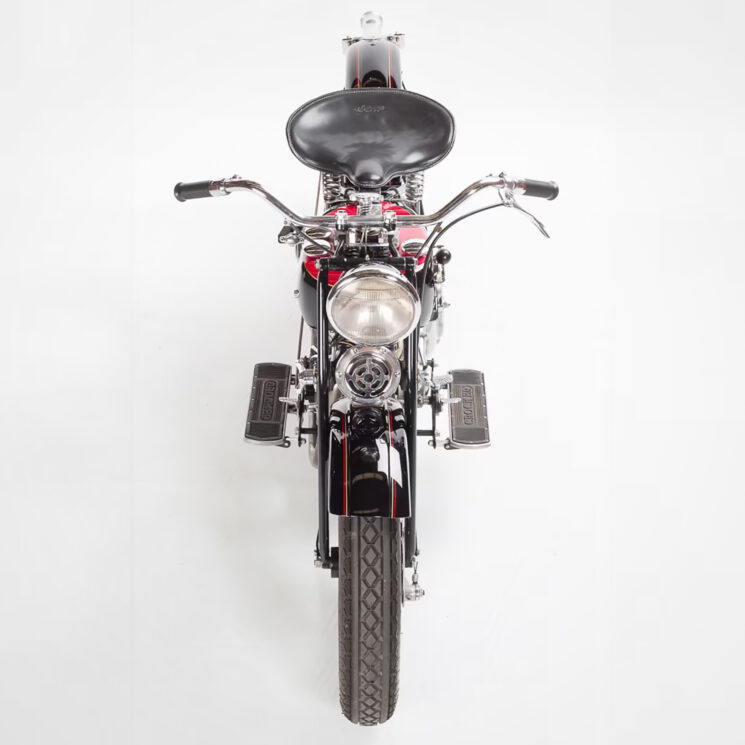
The 1930s proved to be a golden era for V-twin-powered American motorcycles, and if you’re fortunate enough to own one, you’re sitting on a substantial pile of dough. Harley-Davidson’s 1936 EL Knucklehead is regarded by many as the single most desirable classic HD and the right Indian Four will net over $200,000 these days. But that’s relative chump change compared to a little-known marque named Crocker, as one of these precious V-Twins can be worth a half-million to the full seven figures.
Founded in 1901 and 1903 respectively, Indian and Harley-Davidson enjoyed tenured dominance over any would-be newcomers to the American market. Still, Albert Crocker took the opportunity to learn from both marques. An engineer by trade and an accomplished rider on the weekends, Crocker found himself rubbing elbows with Oscar Hedström and Charles Hendee and secured a job at Indian. Crocker would bounce around for a bit, before eventually buying an Indian dealership in Los Angeles.

Crocker kept his restless mind busy by developing speed parts for Indians, working up to an overhead-valve conversion for the Scout for dirt-track racing. With limited success, he moved on to speedway racing and constructed his first single-cylinder race bike by 1930. The overhead valve, 499 cc Crocker Speedway proved dominant in AMA racing for a short time, and roughly 30 bikes were built, but still Crocker had his eyes on something bigger.
By this time Al had left Indian for good, and he set up Crocker Motorcycle Company on Venice Boulevard in L.A. with designer Paul Bigsby (yes, the same Bigsby of Bigsby Electric Guitars). Crocker and Bigsby got to work designing something more lucrative than the speedway machines—something that would appeal to the masses—starting with a massive 61 ci, 1,000 cc V-twin with hemispherical combustion chambers.

The mechanical details of Crocker’s big twin are slim (and the chassis that carried it), but you can’t say the same about the power figures they were achieving. These mag-fired OHV engines are said to have produced 55 to 60 hp. Compared to the low 40s that the EL Knucklehead and Indian Chief were making, it becomes clear that Crocker’s bikes were far ahead of their time. Capable of over 110 mph flat out, Crocker’s Twin was America’s fastest motorcycle and would run with the likes of Vincent and Norton for top-end speed.
Power figures aside, the construction of Crocker’s Twin was similar to that of Harley and Indian of that period. The rigid chassis was designed with a girder-type fork and a single downtube and is assembled with cast joints for fit-up. The split tanks and fenders are eerily reminiscent of the Indian Chief but with less flair. Furthermore, the Crocker Twin looks more stripped down in its stock form than its contemporaries, likely contributing to its handsome 80-pound curb weight advantage.

The Crocker Twin went into production around 1935, but the firm had to rely heavily on suppliers to manufacture parts given the limitations of the Venice Boulevard facility. Lacking the integration of his peers, Crocker’s Twin cost 35% more than the Indian Chief, and that was a tough sell during the Great Depression. Unable to sell his design to Indian, production of the Crocker Twin ended around 1940 after roughly 200 bikes were built. Crocker shifted his focus to scooters for the next couple years before abandoning motorcycles and falling from the pages of history.

Performance and obscurity have been kind to the Crocker marque in the ensuing decades, and an original Crocker Twin will command some of the highest hammer prices an American V-twin can achieve. The early ‘small-tank’ bikes (1936 to 1939) probably command the highest values, but the sample size is so small that any decent Crocker delivers paralyzing sticker shock.
Lot R727 is an exceptional example, a highly documented 1938 small-tank Twin, set to cross the block in February at Mecum’s Las Vegas 2025 sale. The bike comes from the collection of Urban S. Hirsch III and was once owned and restored by the famed Ernie Skelton. Skelton’s name is synonymous with old-school American iron, and there was probably no bigger authority on the brand than him. The PTO side of the crankcase still wears his hand-punched inscription.

The 46th bike constructed, there are perhaps no more prominent examples of the Crocker Twin out there. While it’s selling at no reserve, it certainly won’t come cheap.
Source: Mecum

from Bike EXIF https://ift.tt/1bQeGWF
No comments:
Post a Comment